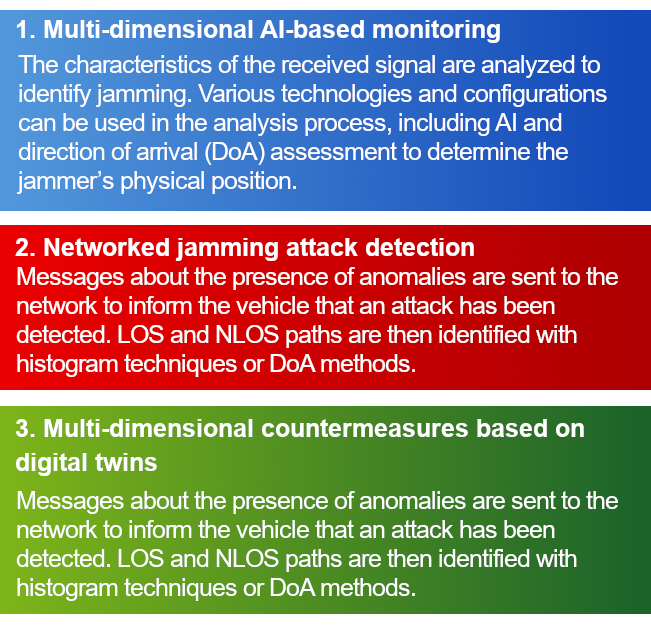Summary
- Profile Type
- Technology offer
- POD Reference
- TODE20240918015
- Term of Validity
- 18 September 2024 - 18 September 2026
- Company's Country
- Germany
- Type of partnership
- Research and development cooperation agreement
- Investment agreement
- Targeted Countries
- All countries
Contact the EEN partner nearest to you for more information.
Find my local partner
General information
- Short Summary
- A new technology from a German university can greatly mitigate radio interference in V2X communication and thus restore security. Interference attacks on various mobile applications can be recognised and mitigated with this technology. The university offers interested companies the opportunity to licence the technology. Further development in co-operation with the inventors is also possible.
- Full Description
-
Driver assistance systems and autonomous vehicles offer many benefits, increasing safety and efficiency. However, wireless communication technology is susceptible to cyber-attacks, which can impair communication and reduce safety.
Scientists of a German university have developed a method to detect and mitigate radio interference. Figure 1 shows a malicious radio-controlled drone that can disrupt vehicle-to-vehicle (V2V) communication when turning left - without line-of-sight. To mitigate radio interference, V2V communication uses wideband MIMO communication, whose precoding or beamforming is optimised with the spatial information from the digital twins.
Figure 2 shows the three basic elements of interference detection and mitigation. The first is multi-dimensional, AI-based monitoring that reduces false positives and false negatives. The second element is networked detection, which uses more information about radio interference to estimate interference propagation and select different optimised techniques for different parts of the map. The third element is multi-dimensional filtering based on digital twins, which allows prediction of the best route and real-time monitoring of radio interference. The invention is, of course, intended for use with reconfigurable intelligent surfaces (RIS).
Initial laboratory samples have been set up, tested, and measured. They have established the invention’s functionality.
The university offers interested companies the opportunity to licence the technology. Further development in co-operation with the inventors is also possible. Companies from the automotive industry and those from the communications technology sector are particularly suitable. - Advantages and Innovations
-
- Contains all network hubs
- Minimizes information loss
- Increases transmission security
- Jamming attack detection
- Reduces jamming attacks - Stage of Development
- Lab tested
- Sustainable Development Goals
- Goal 9: Industry, Innovation and Infrastructure
- IPR status
- IPR applied but not yet granted
- IPR notes
- A German patent application has been submitted to the German Patent and Trade Mark Office. A PCT application can be submitted within the priority year.
Partner Sought
- Expected Role of a Partner
- The university offers interested companies the opportunity to licence the technology. Further development in co-operation with the inventors is also possible. Companies from the automotive industry and those from the communications technology sector are particularly suitable.
- Type and Size of Partner
- Big company
- SME 11-49
- Other
- SME 50 - 249
- SME <=10
- Type of partnership
- Research and development cooperation agreement
- Investment agreement
Dissemination
- Technology keywords
- 01003008 - Data Processing / Data Interchange, Middleware
- 01003022 - Smart Appliances
- 01003003 - Artificial Intelligence (AI)
- 01001001 - Automation, Robotics Control Systems
- Market keywords
- 01004003 - Communications processors/network management
- 01004002 - Data communication components
- Sector Groups Involved
- Mobility - Transport - Automotive
- Targeted countries
- All countries

